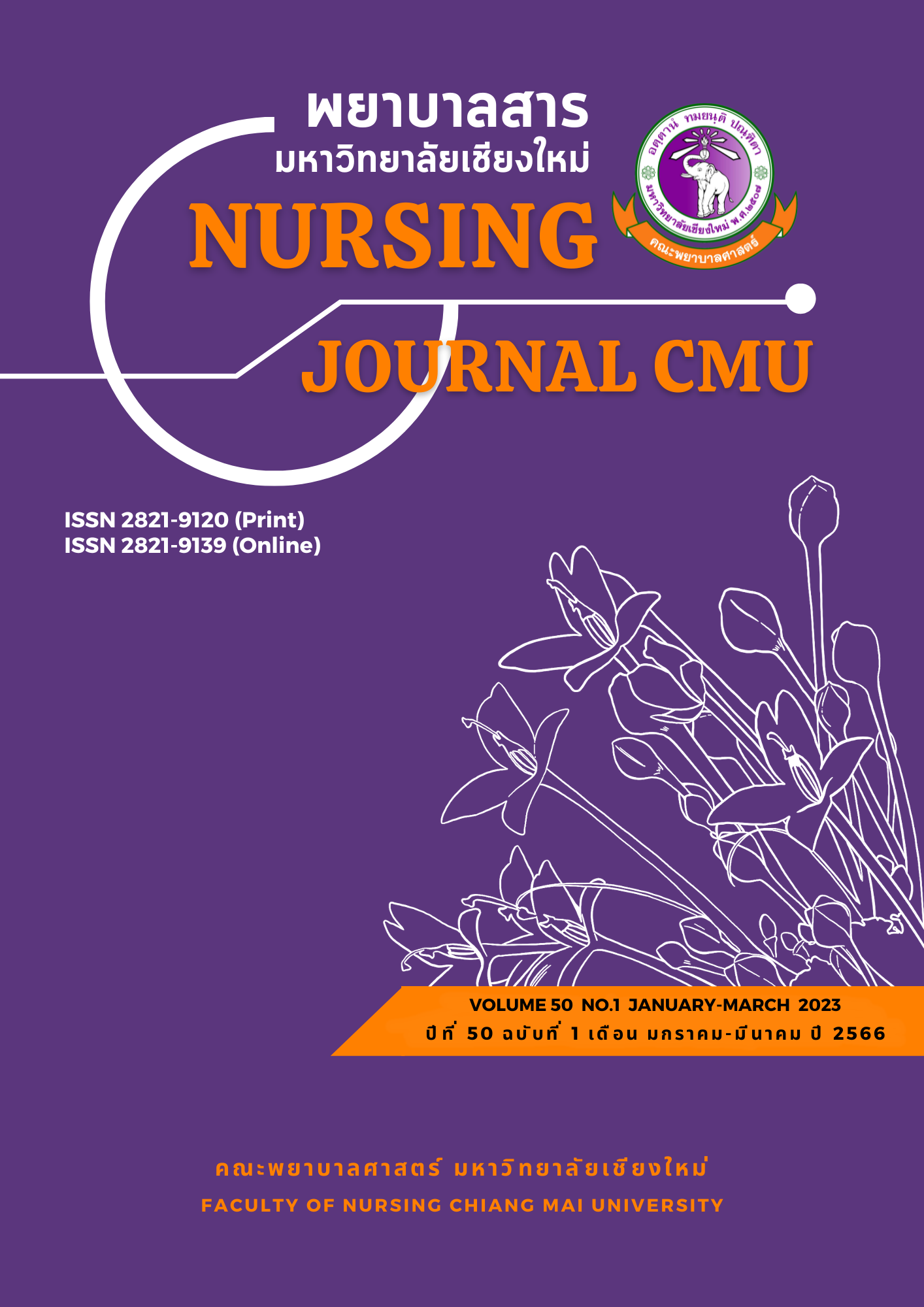Food Literacy and Eating Behaviors Among Chiang Mai University Personnel
Keywords:
Food literacy, Eating behaviors, Personnel of Chiang Mai UniversityAbstract
Food literacy is an essential factor for appropriate eating behaviors. This correlational descriptive research aimed to describe food literacy and eating behaviors, and to explore the association between food literacy and eating behaviors among Chiang Mai University personnel. One hundred and seventy-nine staff from Chiang Mai University were purposively selected as participants in this study. Data were collected by using 1) a demographic data recording form, 2) the short form of a food literacy questionnaire, and 3) the eating behaviors of working persons questionnaire. The data were analyzed using descriptive statistics and Pearson’s product-moment correlation.
The results showed that the participants had a good level of food literacy and overall eating behaviors at a moderate level. For each dimension of eating behaviors, food safety behaviors had a very good level while food health behaviors and drinking behaviors had a moderate level. Food literacy had a significant positive correlation with eating behaviors and eating food safety behaviors at a moderate level (r = .335, .300 respectively), while the correlation with drinking behaviors was at a significantly low level (r = .157).
The results of this study can be used as database information for promoting the eating behaviors of personnel at Chiang Mai University through food literacy enhancement.
References
Aekplakorn, W. (Ed.). (2016). National health examination surveys (5th ed.). Nonthaburi:Augson Graphic and Design. (in Thai)
Aekplakorn, W. (Ed.). (2021). National health examination surveys (6th ed.). Nonthaburi:Augson Graphic and Design. (in Thai)
Chaitokkia, S. (2018). Factors affecting food consumption behaviors of adults in Northeastern Thailand. Research and Development Journal, Loei Rajabhat University, 13(45), 68-78. (in Thai)
Chamnansua, P., Kheokao, J., Chumchai, P., Duangkam, T., Jaruphisitphaibun, C., Hongthong, K., … Meebunmak, Y. (2016). Health information literacy, eHealth literacy, and health status of nursing students in nursing colleges under Jurisdiction of the Praboromarajchanok institute (PBRI), in the central region 2 network and North-Eastern region network. Thai Library Association Research Journal, 9(1), 93-117.
Health Education Division, Department of Health, Ministry of Public Health. (2018). Enhancing and evaluation of health literacy and health behaviors (Rev. ed.). Retrieved from http://www.hed.go.th/linkhed/file/575 (in Thai)
Julsukon, A., Piaseu, N., Thipsuwannakool, V., & Lininger, J. (2019). Nutrition literacy and health outcomes in older adults with type 2 diabetes. Journal of Thailand Nursing and Midwifery Council, 34(4), 120-135. (in Thai)
Kalkan, I. (2019). The impact of nutrition literacy on the food habits among young adults in Turkey. Nutrition Research and Practice, 13(4), 352-357. doi: 10.4162/nrp.2019.13.4.352
Krause, C., Sommerhalder, K., Beer-Borst, S., & Abel, T. (2018). Just a subtle difference? findings from a systematic review on definitions of nutrition literacy and food literacy. Health Promotion International, 33(3), 378-389. doi: 10.1093/heapro/daw084
Lee, Y., Kim, T., & Jung, H. (2022). The relationships between food literacy, health promotion literacy and healthy eating habits among young adults in South Korea. Foods, 11(16), 2467. doi: 10.3390/foods11162467
National Statistical Office Ministry of Digital Economy and Society. (2014). Health behaviour of population survey 2021. Retrieved from http://www.nso.go.th/sites/2014/DocLib13(in Thai)
Onchuenchit, H., Rungsintora, N., Jaroenpacha, P., & Srimool, S. (2016). The coffee consumer behaviors in Muang District, Phitsanulok Province. The Khangphaenfphet Rajabhat University Conference, 3(2), 308-321. (in Thai)
Perry, E., Thomas, H., Samra, H., Edmonstone, S., Davidson, L., Faulkner, A., … Kirkpatrick, S. (2017). Identifying attributes of food literacy: A scoping review. Public Health Nutrition, 20(13), 2406-2415. doi: 10.1017/S1368980017001276
Poonperm, R. (2016). Food consumption behaviors of family in the community of Phramongkutklao hospital personnel’s residence. Journal of The Royal Thai Army Nurses, 17(2), 78-88. (in Thai)
Vaitkeviciute, R., Ball, L. E., & Harris, N. (2014). The relationship between food literacy anddietary intake in adolescents: A systematic review. Public Health Nutrition, 18(4), 649-658.
Vidgen, H., & Gallegos, D. (2014). Defining food literacy and its components. Appetite, 76(1), 50-59. doi: 10.1016/j.appet.2014.01.010
Waratornpaibul, T. (2014). Consumption behavior: Consumerism food and health-conscious food. Panyapiwat Journal, 5(2), 255-264. (in Thai)
Yarmohammadi, P., Morowatisharifabad, M. A., Rahaei, Z., Khayyatzadeh, S. S., & Madadizadeh, F. (2022). Nutrition literacy and its related demographic factors among workers of Taraz Steel company, Chaharmahal and Bakhtiari, Iran. Frontiers in Public Health, 10, 911619. doi: 10.3389/fpubh.2022.911619
Downloads
Published
How to Cite
Issue
Section
License
Copyright (c) 2023 Nursing Journal

This work is licensed under a Creative Commons Attribution-NonCommercial-NoDerivatives 4.0 International License.
บทความที่ได้รับการตีพิมพ์เป็นลิขสิทธิ์ของวารสารพยาบาลสาร
ข้อความที่ปรากฏในบทความแต่ละเรื่องในวารสารวิชาการเล่มนี้เป็นความคิดเห็นส่วนตัวของผู้เขียนแต่ละท่านไม่เกี่ยวข้องกับมหาวิทยาลัยเชียงใหม่ และคณาจารย์ท่านอื่นๆในมหาวิทยาลัยฯ แต่อย่างใด ความรับผิดชอบองค์ประกอบทั้งหมดของบทความแต่ละเรื่องเป็นของผู้เขียนแต่ละท่าน หากมีความผิดพลาดใด ๆ ผู้เขียนแต่ละท่านจะรับผิดชอบบทความของตนเองแต่ผู้เดียว






